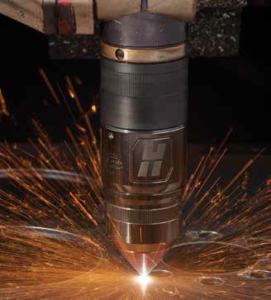We spoke to Theo Cornielje, the regional director for Hypertherm EMEA
 WHY IS PLASMA THE BEST WAY TO CUT STAINLESS STEEL?
WHY IS PLASMA THE BEST WAY TO CUT STAINLESS STEEL?
(Laughs) That’s going too far. There are many applications where a tool like a fibre laser is superior. It really depends on the end result that a client needs. However, what I would say is that Hypertherm’s X-DefinitionTM technology has seriously narrowed the gap, both in terms of cost, and in cut angularity. The edge of a plasma cut will never be exactly 90o, but X-Definition brings it so close that, for many applications, it doesn’t make sense to use a laser.
THE EDGE OF THE CUT IS THAT SHARP?
Well, let me give you an example. At a recent trade show in Germany, we had a booth dedicated to our new XPR300TM plasma cutter. There were
two men there who didn’t believe that the pieces we had on display were plasma cut – they were convinced we’d used a laser.
We were very happy to turn on the test machine and demonstrate it for them. We cut a series of 10cm squares out of 6mm stainless steel. Then, we stood a square on its side, and balanced another on top of it. The cut angularity is so low that we got 5 squares up before the tower became unstable.
You see, I’m not saying that the edge is absolutely as flat as a laser cut, but, in a large range of use cases, it’s effectively equivalent. So the first guy asked how much such a system would cost. I replied that it depends very much on who builds the table and what size it needs to be, but that for an investment of between €100 000 to €200 000, he could expect production quality. He turned to his colleague and asked, “Can you explain why
we just spent €1.2million on a fibre laser?”
THAT’S A SIGNIFICANT DIFFERENCE IN COST.
The actual running cost of an XPR300 is significantly lower, even compared to other plasma cutters. Staying in the ISO-2 quality range, you could easily expect to get more than 1200 20-second cuts out of the same consumable, which is three times more than our nearest competitor. The system is fast, too – you get an extraordinary volume of work out of it.
WHY DON’T PEOPLE JUST REPLACE THEIR LASERS WITH XPR300S, THEN?
There will always be tasks that a laser is better suited to, particularly at very thin thicknesses. But considering the quality and precision that the XPR300 can deliver, it’s a better choice for a wide range of stainless steel cuts, because the end quality is equivalent, but the cost is lower, and the speed is higher.
IS IT POSSIBLE TO RETROFIT AN XPR300 ONTO AN EXISTING CUTTING TABLE?
(Pauses) You could. I’m not sure I would recommend doing so.
WHY NOT?
Well, when I say that the X-Definition technology in the XPR300 is a leap forward, I’m not exaggerating. The older plasma cutters that most people are familiar with have quite a wide cut, which permits a certain level of fault tolerance. By comparison, the XPR300 is an extremely precise tool. If you mount it on a control system that has any wobble in it at all, you’ll see that in the cut.
IF SOMEONE’S INTERESTED IN YOUR CUTTERS, WHERE CAN THEY BUY THEM?
We’re thrilled when fabricators are aware of our products, but we don’t generally sell directly to the fabrication market. We deal more with what we call OEMs – companies that will build cutting systems that feature our technology. In South Africa, we have a strong relationship with CNC Clearcut, for example, who build systems based on our systems. We have many other partners in the region, too.

